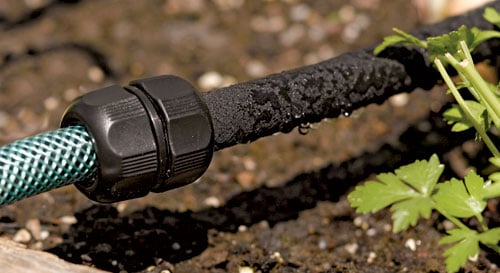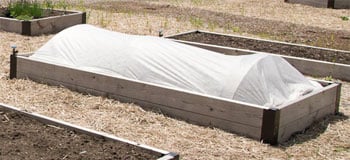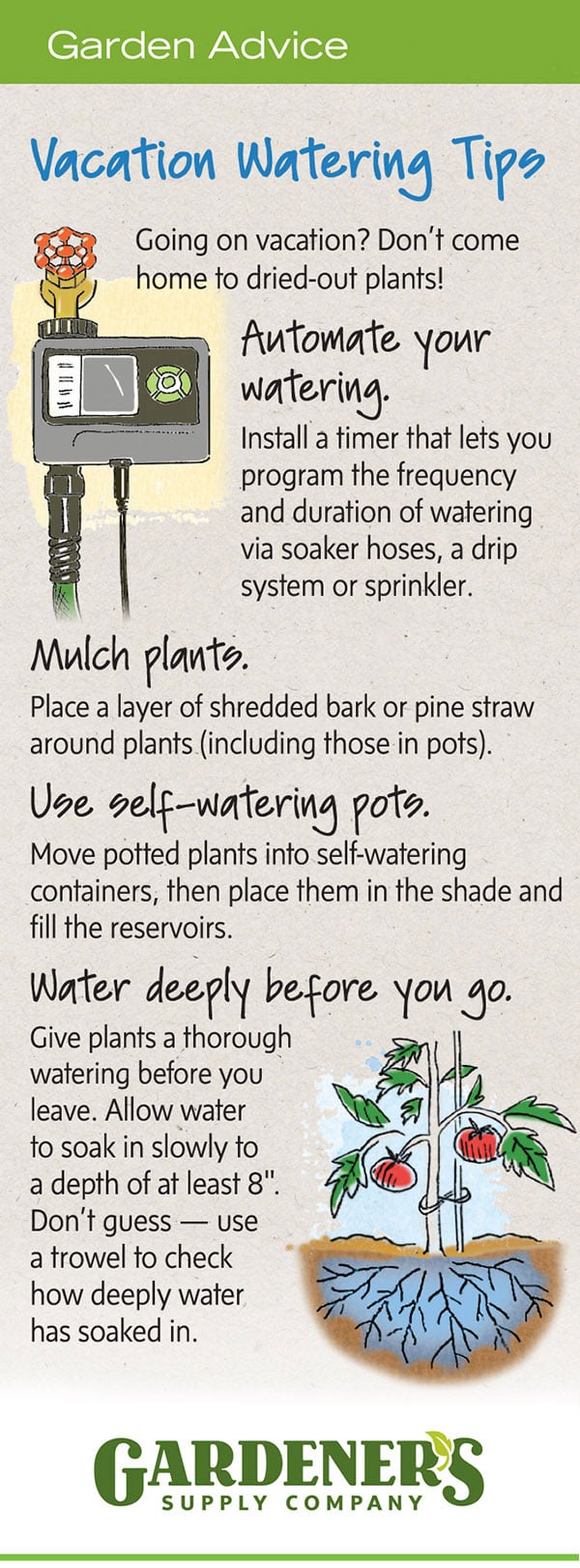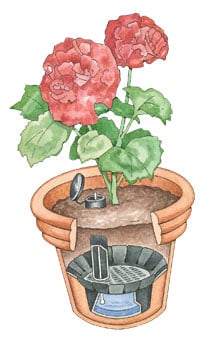Tips for Watering While You're Away on Vacation
How to keep your garden, lawn & houseplants watered and cared for when you're on a trip

Soaker hoses, such as the Snip-n-Drip Soaker System, can be used with timers to make sure garden beds get watered while you're away.
A week's vacation during the summer might be a welcome break for you, but the absence of a doting gardener can wreak havoc on your indoor and outdoor plants. Here are some tools, tips, and techniques that will help plants thrive while you're away, so you can come home from your trip to healthy gardens and happy houseplants. And, if you live in a dry climate, these tips can help your plants thrive even if you're not out of town.
| In this article: |
Vacation-Proof Watering Solutions for Gardens & Outdoor Plants
As you plan your departure, consider the following:
- How long will you be away? If you're going away for a weekend, most garden plants will survive if you give them a good soaking just before you leave. Any longer and you may need to take action to keep plants healthy.
- What types of plantings do you have? Newly seeded vegetable beds and lawns, hanging baskets and small pots may need daily watering and will require more preparation. Established plants in garden beds and those in large planters are more resilient.
- What's the weather forecast? If predictions call for a spell of hot, sunny weather, you'll want to make sure your plants are especially well prepared.
Plants in different growing situations will need individual watering plans. If you don't have a trusted gardening friend to visit your plants once or twice a week, try these tips for keeping containers and gardens happy.
Keep Pots & Planters Watered While You're Away
1. Move Plants into Shade
Move pots and hanging baskets to a spot that's shaded most of the day, especially in the afternoon. If no other shade is available, move them into the garage. A week or so of reduced light may temporarily cause leggy growth or reduced flowering, but plants will recover. Be mindful, however, that removing planters from their usual location, combined with accumulating newspapers or mail, could signal that you're out of town.
2. Huddle Plants for Humidity
Group containers close together to create a humid microclimate that helps conserve water. Applying a layer of bark mulch to the soil surface of containers also helps hold in moisture.
3. "Plant" Pots to Cool Roots
The smaller the pot, the quicker it can dry out or overheat. Sinking smaller pots into the soil, even just a few inches, can help conserve moisture and keep roots cool.
4. Upgrade to Self-Watering Pots
Consider moving plants into self-watering planters. These planters have a water reservoir that can provide plants with a source of water for several days to several weeks, depending upon the size of the planter and reservoir, the age and type of plants, and the weather. Our Self-Watering Conversion Kits allow you to convert most pots into self-watering planters.
5. Water Deep Before You Leave (Of Course)
Though it's obviously the first thing you'd think of, the last thing you should do before you leave (and after attending to any of the shuffling discussed above), is to water all your plants thoroughly! Soak pots and hanging baskets in a Tubtrug or bucket of water to ensure that moisture penetrates to the center of the pot.

This bed of seedlings is protected from intense summer sun with a covering of Garden Fabric.
How to Water Vegetable Gardens & Landscape Plants While on Vacation
You may not need to use all of the solutions below, but it's possible to combine any and all of them to ensure that your vegetable gardens stay vibrant and your perennial plants preserve their pep while you're enjoying some rest and relaxation.
1. Consider an Irrigation System
Our innovative Irrigation Systems are the best of both worlds, targeting moisture around the root zones of your plants, while also watering more slowly and more deeply, letting moisture penetrate further into the soil, and reducing evaporation.
2. Watering Timers Are Perfect for Extended Trips
While they're always a helpful solution to make sure your garden gets consistently hydrated, a programmable timer is a stellar way to create convenient and automatic vacation watering solutions. To conserve water and limit loss from evaporation, set your timer to water early in the morning. Before you leave, set up your soaker systems and experiment with different timer settings to see what works best for each situation. A newly planted row of seeds might need a half-hour of watering each morning, for example, while a row of established blueberry shrubs would be better off with a deep, 2-hour watering once a week. A multi-zone timer like our 4-Zone Bluetooth Water Timer lets you program different watering settings for different irrigation needs.
3. Add Mulch to Keep Soil Moist
Apply a layer of mulch around landscape and vegetable plants. Grass clippings, bark mulch, leaf mold, and compost will shade the soil, helping to retain moisture and regulate temperature.
4. Cover with Garden Fabric
In windy locations, cover vegetable plants with Summerweight Garden Fabric to protect them from drying winds and hold moisture in the soil. You can cover entire garden rows or wrap it around individual support cages.
5. Water Deep Before You Leave (Duh)
Again: first thought, last task: Deeply water the root zones of new or vulnerable plants just before you leave. Allow the water to soak in slowly to a depth of at least 6" to 8".

How to Care For Your Lawn When You're Gone
1. Let it Grow
Mow your lawn just before you leave, but cut it a bit higher than you normally would. Taller grass is more resistant to drought — because it shades the soil below and typically has deeper root systems than grass that has been shorn short. Leave the clippings in place to add moisture-retentive organic matter to the soil.
2. Set up the Sprinkler
A quality sprinkler system connected to a programmable timer, lets you create a customized system for watering the lawn on a schedule. While a dripline or irrigation system is best for individual shrubs or garden rows, a sprinkler system can broadcast water over a larger area. A stationary raised sprinkler is ideal for small, circular lawn spaces, while an oscillating system is great for large, rectangular areas.
3. Time Watering Right
Sandy soils and newly seeded lawns require frequent — even daily — watering, especially during hot weather. Established turf lawns, on the other hand, benefit from a deep, weekly soaking. Use a timer to set the right frequency and duration for your situation. Set sprinklers to run in the early morning to maximize the amount of water that makes it to the roots.
Come Home to Happy Houseplants
1. Quick Tips for Short Trips
If you'll only be gone for a few days, simply move your houseplants out of direct sunlight — close the shades or shift them toward the center of the room. This will slow growth and reduce moisture loss. Water thoroughly right before you depart, making sure that moisture penetrates to the center of the root ball.
2. Build a (Temporary) Greenhouse
Many houseplants will thrive in a temporary bathtub greenhouse, especially low-light, tropical foliage plants. Leave the light on in the bathroom, and you should return to a tub full of healthy plants. Here's how to do it:
- Line the tub with a large plastic sheet or an old towel, to avoid damaging the tub
- Place plants on the towel and turn the shower on long enough to wet the towel
- Pull the shower curtain closed to help retain moisture
3. Phone a Friend
If a friend or neighbor will be tending your houseplants while you're away, make it simple for them. Connect indoor hoses and sprayers to the sink before you leave, and pre-fill your misters and watering cans with water to make that first visit to your home super easy. Organize houseplants by watering needs — separate the cactus from the African violets. It's easier for your vacation helper to water groups of plants than to memorize individual plants' needs.
While nothing can replace an attentive gardener when it comes to keeping plants healthy, with some planning and, ideally, a helpful gardening friend, you can come home from your vacation to thriving plants, indoors and out.
Print this Article:
Get the Dirt
Stay up to date on new articles and advice. Please fill out the information below.

